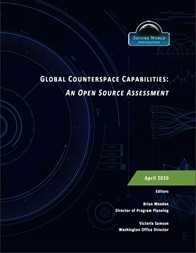Global Counterspace Capabilities
 |
||||
|
Current Version:
|
||||
|
Previous versions:
|
Background
Space security has become an increasingly salient policy issue. Over the last several years, there has been growing concern from multiple governments over the reliance on vulnerable space capabilities for national security, and the corresponding proliferation of offensive counterspace capabilities that could be used to disrupt, deny, degrade, or destroy space systems. This in turn has led to increased rhetoric from some countries about the need to prepare for future conflicts on Earth to extend into space, and calls from some corners to increase the development of offensive counterspace capabilities and put in place more aggressive policies and postures.
We feel strongly that a more open and public debate on these issues is urgently needed. Space is not the sole domain of militaries and intelligence services. Our global society and economy is increasingly dependent on space capabilities, and a future conflict in space could have massive, long-term negative repercussions that are felt here on Earth. Even testing of these capabilities could have long-lasting negative repercussions for the space environment, and all who operate there. The public should be as aware of the developing threats and risks of different policy options as would be the case for other national security issues in the air, land, and sea domains.
Highlights from the 2020 Report
China
- Conducted additional rendezvous and proximity operations (RPO) of their SJ-17 to inspect a potential anomaly with Chinasat 5C in GEO
- Reports of widespread GPS jamming near port of Shanghai
- Additional details on Chinese ground-based directed energy facilities
Russia
- New research suggesting tho have two separate programs, Burevestnik and Nivelir, which may correspond to a co-orbital ASAT program and a surveillance/tracking program, respectively
- Conducted additional RPO activities in LEO and GEO, including shadowing of a NRO imagery satellite
- Evidence of a new program called Ekipazh to develop nuclear-powered space-based electronic warfare capability
- Widespread PNT jamming and spoofing in Crimea, Syria, and Russia
United States
- Conducted covert release of cubesats from X-37B OTV-5
- More public details on the RPO activities of GSSAP and Mycroft
- Widespread GPS jamming for naval exercises in the southeastern U.S.
- Re-establishment of the United States Space Command and creation of the United States Space Force
France:
- Overview of the new French Space Defense Strategy and plans for ground-based lasers and guardian satellites
India
- Updated information on March 2019 ASAT test
- Information on the establishment of the Defence Space Agency and the Defence Space Research Organization
Iran
- Information on attempted Iranian satellite launches in August 2019 and February 2020
- Reports of Iranian GNSS jamming occurring near the Straits of Hormuz
Japan
- Information on their exploration of counterspace capabilities
For more information or media inquiries, please contact SWF Director of Program Planning Dr. Brian Weeden at bweeden@swfound.org or Washington Office Director Ms. Victoria Samson at vsamson@swfound.org.

 Share
Share